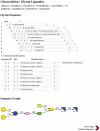Glycan Reader is improved to recognize most sugar types and chemical modifications in the Protein Data Bank
- PMID: 28582506
- PMCID: PMC5870669
- DOI: 10.1093/bioinformatics/btx358
Glycan Reader is improved to recognize most sugar types and chemical modifications in the Protein Data Bank
Abstract
Motivation: Glycans play a central role in many essential biological processes. Glycan Reader was originally developed to simplify the reading of Protein Data Bank (PDB) files containing glycans through the automatic detection and annotation of sugars and glycosidic linkages between sugar units and to proteins, all based on atomic coordinates and connectivity information. Carbohydrates can have various chemical modifications at different positions, making their chemical space much diverse. Unfortunately, current PDB files do not provide exact annotations for most carbohydrate derivatives and more than 50% of PDB glycan chains have at least one carbohydrate derivative that could not be correctly recognized by the original Glycan Reader.
Results: Glycan Reader has been improved and now identifies most sugar types and chemical modifications (including various glycolipids) in the PDB, and both PDB and PDBx/mmCIF formats are supported. CHARMM-GUI Glycan Reader is updated to generate the simulation system and input of various glycoconjugates with most sugar types and chemical modifications. It also offers a new functionality to edit the glycan structures through addition/deletion/modification of glycosylation types, sugar types, chemical modifications, glycosidic linkages, and anomeric states. The simulation system and input files can be used for CHARMM, NAMD, GROMACS, AMBER, GENESIS, LAMMPS, Desmond, OpenMM, and CHARMM/OpenMM. Glycan Fragment Database in GlycanStructure.Org is also updated to provide an intuitive glycan sequence search tool for complex glycan structures with various chemical modifications in the PDB.
Availability and implementation: http://www.charmm-gui.org/input/glycan and http://www.glycanstructure.org.
Contact: wonpil@lehigh.edu.
Supplementary information: Supplementary data are available at Bioinformatics online.
© The Author (2017). Published by Oxford University Press. All rights reserved. For Permissions, please email: journals.permissions@oup.com
Figures







References
-
- Abraham M.J. et al. (2015) GROMACS: high performance molecular simulations through multi-level parallelism from laptops to supercomputers. SoftwareX, 1–2, 19–25.
-
- Apweiler R. et al. (1999) On the frequency of protein glycosylation, as deduced from analysis of the SWISS-PROT database. Biochim. Biophys. Acta, 1473, 4–8. - PubMed
-
- Bohne A. et al. (1999) SWEET - WWW-based rapid 3D construction of oligo- and polysaccharides. Bioinformatics, 15, 767–768. - PubMed
MeSH terms
Substances
LinkOut - more resources
Full Text Sources
Other Literature Sources

